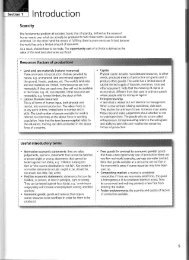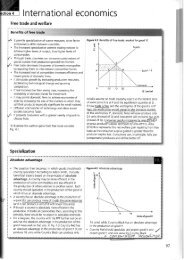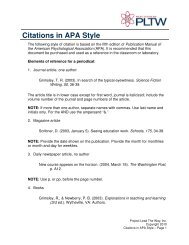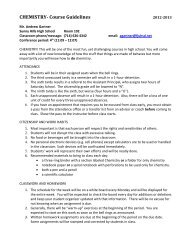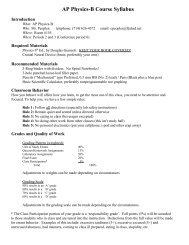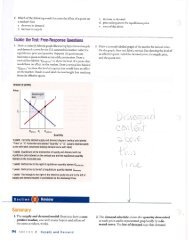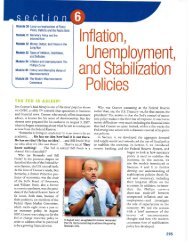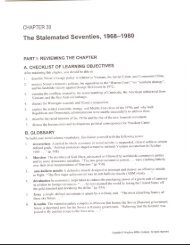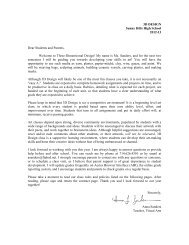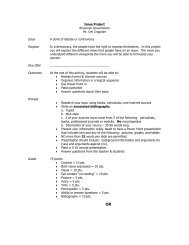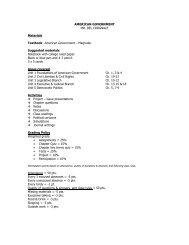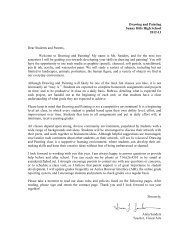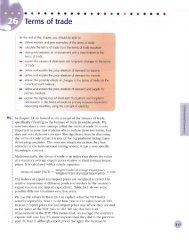AP Econ Module 41 Capital Flows Balance Payments - Sunny Hills ...
AP Econ Module 41 Capital Flows Balance Payments - Sunny Hills ...
AP Econ Module 41 Capital Flows Balance Payments - Sunny Hills ...
You also want an ePaper? Increase the reach of your titles
YUMPU automatically turns print PDFs into web optimized ePapers that Google loves.
Equation <strong>41</strong>-3 is equivalent to Equation <strong>41</strong>-1: the current account plus the financial<br />
account-both equal to positive entries minus negarive enrries-is equal to zero.<br />
But what determines the current account and the financial account?<br />
Modeling the Financial Account<br />
A country's financial account measures its net sa.les ofassets, such as currencies, securi-<br />
ties, and Factories, to foreigners. Those assets are exchanged for a qpe ofcapital called<br />
fnancial capital, which is funds from savings that are available for investmenr spending.<br />
'We can thus thinl< ofthe financial account as a mea.sure of capiwlinfloas in the form of<br />
foreign savings that become available to finance domestic investment spending.<br />
What determines these capital inflows?<br />
Part ofour explanation will have to wait for a little while because some internarional<br />
capital flows are created by govemments and central banks, which somecimes act very<br />
differendy from private investors. But we can gain insight into the motivations for capital<br />
flows that are the result of private decisions by using rh e loanablc funds rnodel we developed<br />
previously. In using this model, we make two important simplifications:<br />
r Ve simplify the reality ofinternational capital flows by assuming that all flows are<br />
in the form ofloans. In reality, capital flows take many forms, including purchases<br />
of shares of stock in foreign companies and foreign real esttte as well as foreign direct<br />
investment, in which companies build factories or acquire other productive assets<br />
abroad.<br />
r We also ignore the effects ofexpected, changes in exchange ra,tet the relative values<br />
of different national currencies. We'll analyze the determination of exchange<br />
rates later.<br />
Figure <strong>41</strong>.2 recaps the loanable funds model for a closed economy. Equilibrium corresponds<br />
to point 4 at an interest rate of4%, at which the supply ofloanable funds (S)<br />
intersects the demand (D). If intemational capital flows are possible, this diagram<br />
changes and E may no longer be the equilibrium. We can anaJyze the causes and effects<br />
of intemational capital flows using Figure <strong>41</strong>.3 on the next page, which places the<br />
loanable funds market diagrams for two counries side by side.<br />
Figure 4L3 illustrates a world consisting ofonly two countries, the United States<br />
and Britain. Panel (a) shows the loanable funds market in the United States, where<br />
The Loanable Funds Model<br />
Revisited<br />
According to tie loanabl8 tunds modolofthe in-<br />
terest rate, ft€ squilibrium interest rate is determlnod<br />
by fie intersection of the supply ol<br />
loanable funds curve, S, and the demand tor<br />
loanable funds curve, AAt point E the equilib-<br />
rium interest rah is 4%.<br />
Quantity of loanable funds<br />
module <strong>41</strong> <strong>Capital</strong> <strong>Flows</strong> and the <strong>Balance</strong> of <strong>Payments</strong> 475



